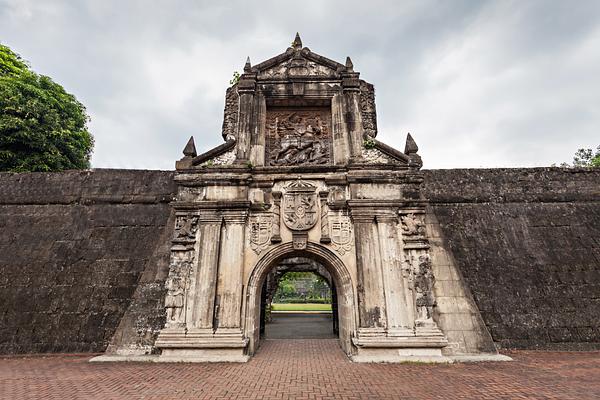
Why Visit Fort Santiago Intramuros?
Whatever you do, don’t miss Fort Santiago. It’s the heart of Intramuros and your journey should start here
Fort Santiago is definitely a must-visit because of its rich history and cultural importance in the Philippines. A lot of significant and tough events for Filipinos happened here.
You’ll need about two to three hours to really explore Fort Santiago. By the end of your visit, you’ll understand why the Spanish picked this location
You’ll get why the Spanish picked that spot for their fort in the first place, learn about the Philippines’ fight for independence, and dive into who José Rizal really was. You’ll also discover what Fort Santiago’s role was during World War II, plus a lot more interesting history and stories along the way.
When I was in college, we took a required tour of Fort Santiago. After visiting, I realized how little I knew about my own country’s history and José Rizal.
For local tourists, being in Fort Santiago feels very different from reading about Rizal’s imprisonment.
Walking around Fort Santiago really brings history to life, and it’s one of those spots that leaves you reflecting on the Philippines’ past and how far the country has come.
A Historical Overview of Fort Santiago
Spanish Colonial Era
Fort Santiago, located in Manila, Philippines, is one of the country’s most historically significant landmarks. Spanish conquistadors built the fort in 1571 to defend Manila. Its name honors St. James, the patron saint of Spain. They built it on the site of an earlier structure, the “Baluarte de San Diego,” used by pre-colonial people led by Rajah Sulayman.
The fort served as a military headquarters and housed soldiers and weapons. Authorities also used it as a prison for political prisoners and revolutionaries. José Rizal, the national hero of the Philippines, was imprisoned here in 1896 on charges of treason and sedition. He was executed on December 30, 1896, in Bagumbayan (now Luneta Park), sparking resistance against Spanish rule and fueling the Philippine Revolution
American Period & Philippine-American War
After the Spanish-American War in 1898, the Philippines came under American control. The U.S. military repurposed Fort Santiago as a strategic base. During the Philippine-American War in 1899, many Filipino insurgents were imprisoned at the fort.
Japanese Occupation & World War II
During World War II, Japanese forces occupied the Philippines. They used Fort Santiago as a prison for American and Filipino soldiers. Many endured brutal conditions. The fort also played a role in the Bataan Death March, holding prisoners before transferring them to concentration camps. The Battle of Manila in 1945 heavily damaged the for
In the years following the war, efforts were made to restore Fort Santiago, and it is now a prominent historical site. Today, it is part of Intramuros, the walled city of Manila, and serves as a popular tourist destination. The fort houses the Rizal Shrine, which commemorates the life and legacy of José Rizal through various exhibits and memorabilia. Visitors can explore its walls and reflect on its complex history as a symbol of the Philippines’ colonial past and the struggles for independence.
Key Historical Events at Fort Santiago
The Rizal Shrine
The Rizal Shrine is a museum dedicated to José Rizal’s life and legacy. You can see his personal belongings, documents, and memorabilia. The shrine sits where Rizal was held before his execution, making it both educational and emotional
The Fort’s Architecture and Grounds
Wander through the fort to see its colonial-era architecture. Thick stone walls, watchtowers, and gates reveal the fort’s original design for defense. You’ll also find courtyards, gardens, and pathways that highlight its military history
The Dungeons and Prison Cells
Explore the old prison cells and dungeons where revolutionaries and prisoners of war were held. These cramped, dark spaces show the hardships they endured during Spanish and Japanese occupations.
Exhibits and Educational Displays
The fort also has various historical exhibits and displays that offer in-depth information about the fort’s role in Philippine history. These exhibits help visitors understand the different periods of Philippine history, from Spanish colonization to World War II and beyond. You’ll find well-curated displays that showcase artifacts, photographs, and documents, bringing the past to life.
The New Pasig River Esplanade
The New Pasig River Esplanade is the hottest tourist attraction in Intramuros right now. This newly developed area along the river offers a scenic view of the waterway and the historic district of Intramuros. It serves as a riverside promenade, with walkways and recreational spaces for visitors to enjoy the beauty of the Pasig River.
Practical Tips for Tourists Visiting Fort Santiago
- Opening Hours & Entrance Fees:
Fort Santiago, located within Intramuros in Manila, operates daily from 8:00 AM to 11:00 PM, with the last entry allowed at 10:00 PM. The entrance fees are as follows:
- Regular Rate: ₱75
- Discounted Rate: ₱50
- Best Time to Visit: Advise tourists on the best time to visit—early mornings or late afternoons to avoid the midday heat, or during the weekdays to miss the weekend crowds.
- Interactive and Guided Tours
If you want to deepen your understanding of the fort’s history, consider taking a guided tour. Knowledgeable guides can provide additional context and anecdotes about the fort’s significant
Sources:
National Historical Commission of the Philippines (NHCP) – www.nhcp.gov.ph
“Intramuros: The Walled City” by Luis R. Teodoro
Philippine Historical Association (PHA) – www.philippinehistory.org
Philippine Revolution: The Epic of the Katipunan by Pio Valenzuela
Tourism Website for Manila – Intramuros Administration website.
